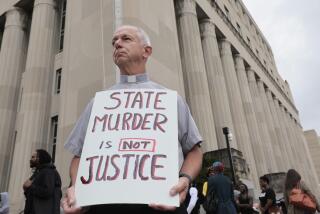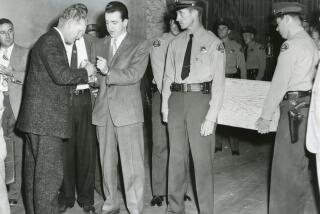Bringing back ‘The Dead Alive’
- Share via
CHICAGO — As executive director of the Center on Wrongful Convictions at Northwestern University’s law school, Rob Warden is an expert on miscarriages of justice. So it’s natural that he would be drawn to the tale of Stephen and Jesse Boorn.
The two young Vermont farmers were falsely convicted of murdering their ne’er-do-well brother-in-law, and even though it happened in 1819, it’s precisely the sort of case the center handles. Since its founding in 1999, the center has been involved in 11 of Illinois’ 18 recent death row exonerations and about a dozen exonerations on noncapital convictions.
But the Boorns don’t need exoneration. Stephen escaped the gallows and Jesse was released from life imprisonment a few months after they were convicted because their so-called victim, Russell Colvin, dramatically reappeared. Colvin hadn’t been dead; he’d merely been in New Jersey.
“It’s America’s first wrongful conviction case on record, and it’s an example of the ‘dead alive’ -- something that was the gold standard for wrongful conviction cases in the pre-DNA age,” Warden said. “It also contains three elements we find in many wrongful conviction cases to this very day: coerced false confessions, testimony from jailhouse snitches and the reliance of the prosecution on junk science.”
Because of Warden’s fascination with the 186-year-old case, he is reissuing “The Dead Alive,” an 1874 British mystery novel based on the Boorns’ ordeal. It was written by Charles Dickens’ friend and occasional collaborator, Wilkie Collins.
“When you mention Wilkie Collins, people have generally heard of ‘The Moonstone’ or ‘The Woman in White’ -- and maybe even have read them,” Warden said. “But no one seems to have heard of ‘The Dead Alive.’ I mentioned it to [attorney and best-selling legal thriller author] Scott Turow, and he didn’t know it -- and he’s an expert on crime novels.”
Warden was unaware of the novel until several years ago when he was preparing a lecture for the Cardozo School of Law in New York. One of the sources he used was a 1933 study of wrongful convictions written by Yale University law professor Edwin Borchard, which mentioned the Boorn case and noted that Collins had written a fictionalized version of it. Later, while writing a law review article for the University of Missouri, Warden decided to find a copy of the novel.
“I did a search for it and finally located a nice first edition for $150,” he said. “It’s quite short. I literally read all of it on my way to New York -- while riding from my house to O’Hare [airport], and then on the plane. I was quite taken with it, and decided to find out how Collins came to write it. I also got curious about how many other ‘dead alive’ cases there have been.”
Warden’s research revealed that there have been seven such murder cases, involving nine defendants and ranging from 1872 to 1973. In two of the cases, men were hanged, only to have their supposed victims later show up alive and well. “They make a pretty good case against the death penalty,” he said.
Warden also discovered that Collins learned of the Boorn case while making his only American book tour. Collins visited Albany, N.Y., in September 1873, and someone gave him a pamphlet Leonard Sargeant, one of the Boorns’ defense attorneys, had written about the case 50 years after the fact.
Collins, who had trained in the law, took only a few months to turn the plot of the pamphlet into a novel. He changed the names and locale, compressed the events of eight years into a few weeks, and added a chaste romantic subplot. But Collins preserved most of the legal details.
“The Dead Alive” has long been out of print, but as a public domain work by a well-known author, it’s available online. Warden feels it deserves a wider audience, so he has arranged with Northwestern University Press to bring out a new edition this winter, complete with the original illustrations. And he has added a 70-page afterword in which he gives the details of the real Boorn case, accounts of other “dead alive” cases and a list of 234 Americans known to have been wrongfully convicted of capital crimes.
Turow, who read the novel at Warden’s urging, contributed a brief foreword, in which he disputes the frequent claim that Collins was the father of the detective novel, but also argues that “The Dead Alive” is the world’s first legal thriller -- the genre he writes in himself.
More to Read
Sign up for our Book Club newsletter
Get the latest news, events and more from the Los Angeles Times Book Club, and help us get L.A. reading and talking.
You may occasionally receive promotional content from the Los Angeles Times.









